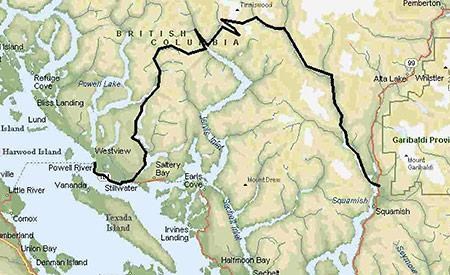Just over a year ago, the Third Crossing Society, which advocates for a highway connection between Powell River and the Lower Mainland, had 70 members and a shiny new business plan. Today, the society is over 140 strong and has garnered the support of regional groups and organizations.
“It’s a slow process,” explained current president Lorne Craig. “Nobody should be under the illusion that anything will happen quickly.”
But although the process is slow, the progress is undeniable.
So far, the group has received a vote of support in principal from the Powell River Regional District, the Powell River Chamber of Commerce and Tourism Powell River. The Tla’amin (Sliammon) First Nations band has also drafted a letter of support.
Some non-local organizations that would be affected, such as the Squamish-Lillooet Regional District and the Pemberton Chamber of Commerce, have backed the idea as well.
The group also recently presented to representatives from the Sechelt First Nations band and are waiting to hear their verdict.
The proposed highway would link Highway 101 to Highway 99 of the Sea to Sky Highway. The road, dubbed a mid-province corridor, would connect the communities of Powell River and Vancouver Island with Squamish and nearby cities, such as Whistler and Lillooet. Society members believe a highway such as this would stimulate the economy of all communities along the route, boost tourism and ease congestion in the Vancouver area.
The society’s suggested route for the road would go through Lausman Pass to the head of Jervis Inlet and then down to Squamish, using many kilometres of pre-existing logging roads. The group estimates the cost of the entire project is$503 million, including a $30 million tunnel.
Craig is looking for volunteers to go on a number of trail-building hikes this summer, including one to explore the Lausman Pass. The society aims in the future to build a trail between Powell River and Squamish.
Also planned for the future is a renewed emphasis on recruiting groups from other communities. Letters are being mailed to the municipalities and regional district in Courtenay and Comox, as well as the Squamish Chamber of Commerce.
“As a cross-province corridor, we hope that eventually other communities will see value in the idea and get involved,” Craig said. “One of our big objectives this year is to get around some of the core municipalities and find out how they feel about the project.”
Not all ventures, however, have been successful. Attempts to win the support of MLAs and MPs have been repeatedly rebuked, said Craig. Also refused was an application to the Powell River Community Forest Ltd. for funds to survey part of the route.
Craig said he’s not disheartened. What’s most important, for him, is sticking power.
“We’re not too worried about having all these goals met in a short period of time,” he explained. “We’re more concerned about building up a group of people and a society that will be more consistent over a longer time period.” He added that movements in the past, though plentiful and passionate, have always fizzled out.
The society also sometimes experiences sharp criticism. It refutes claims that a mid-province corridor would increase crime rates in the region, or lower ferry traffic. Another common thread is residents doubting a road will be built in their lifetime. “It’s probably true,” agreed Craig. “Highways like this take decades. Typically you have a span of 15 to 20 years before construction starts, and then another five to 10 years of construction.”
But for Craig and other members of the Third Crossing Society, the time, the money and the effort are all worth it. As Craig put it, “it’s the difference another connection to Canada can make.”
For more information about the Third Crossing Society, its history and activities, interested readers can visit



